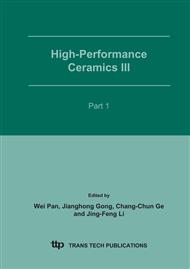p.1713
p.1717
p.1721
p.1725
p.1731
p.1739
p.1745
p.1751
p.1757
The Brazilian Reliability Test and Micromechanical Modelling for Channelled Cylinders of Multiphased Porous Ceramics
Abstract:
Channelled hollow ceramic cylinders have been sliced into discs of equal thickness and submitted to an adapted diametral compression, or brazilian, test such as to evaluate their reliability. The mean Weibull modulus, of m » 18, is representative of a rather good homogeneity of the ceramic material. The shapes of the distributions reveal a probable multimodality. This is analyzed in superimposing possible unimodal distributions of given characteristic value, Weibull modulus and number of items, and comparing to the experimental plot. Iterative modifications are made until a convincing superposition is attained. Complementary numerical simulations on “thermomechanically equivalent microstructures” have been created on the computer observing actual stereological data. The micro-mechanical model accounts for cracking of grain interfaces until specimen separation. Weibull plots for model structures under pore pressure suggest multimodal distributions with moduli ranging as in the measurements. The larger scatter at higher rupture pressures may indicate a varying degree of quasi-brittleness.
Info:
Periodical:
Pages:
1731-1738
Citation:
Online since:
February 2007
Price:
Сopyright:
© 2005 Trans Tech Publications Ltd. All Rights Reserved
Share:
Citation:


